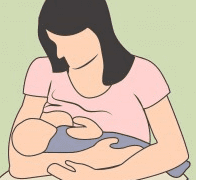Breastfeeding is the healthiest and best way to feed a baby, but when your little one arrives it seems more challenging than expected. While breastfeeding is natural, it doesn’t always come naturally. Both you and your baby must learn how to nurse.
Take a breastfeeding course before baby is born; talk to lactation consultants at your birthing center or provider’s practice. Learn as much as you can ahead of time and then tackle the top three feeding problems with these tips:
Get Into Position
At each feeding, your baby must take in the entire nipple and areola of your breast. Try one of the popular nursing positions that also promote a good latch: cross-over, football hold, or side-lying hold (see “Healthy Breastfeeding Positions”).
Check Your Milk Supply
An inadequate milk supply is actually rare and more typically a perception problem. If your baby is latching properly and you’re seeing sucking and swallowing, your baby is getting enough milk. Right after birth, your body produces colostrum. This earliest milk is smaller in volume but packed with nutrients and is all your baby needs in the beginning.
Most newborns want and need to nurse 8-12 times every 24 hours, and will give you wet diapers in return. Babies typically take from 10-45 minutes per feeding at the start. Your baby is getting enough milk if she has 1 wet diaper per day of life through the first week, then at least 6-7 wet diapers daily after the first week. So at 1 day of age, she should have at least 1 wet diaper, at 4 days of age, she should have at least 4 wet diapers, etc. This is also true if your breasts are filling and then softening, or emptying, at each feeding. If you need to supplement your nursing, find a human milk bank through the Human Milk Banking Association of North America at www.hmbana.org.
Avoid Nipple Confusion
Introducing a bottle or pacifier too early can complicate nursing because babies have to suck differently on natural versus artificial nipples – even the ones designed to mimic your body. Wait 3-4 weeks before introducing artificial nipples to avoid this problem. Even babies who need supplementation for medical reasons can get that without a bottle; talk to your nurse or lactation consultant if your baby has this need.
Healthy breastfeeding positions
The following positions help your baby maintain a good latch
Cross-over: Hold your babe in the arm opposite the breast at which she’ll be nursing, with her head in your hand and her body along your forearm, and lift her to your breast. Add a pillow, such as a Boppy, to support her weight under your arm.
Football hold: Tuck your babe under your arm adjacent to the breast from which she will be nursing, face toward your breast, with her head in your hand and her body resting on your forearm. This removes contact with your abdomen if you’ve had a cesarean birth and is good for nursing twins.
Side-lying hold: You and baby lay on your sides, tummy to tummy, as you lift your breast with one arm while you gently guide baby’s head to latch with your other arm. This works when you’re uncomfortable sitting upright.
Related articles
Breasfeeding Basics: You, Your Baby & Your Nurses







Comments are closed.